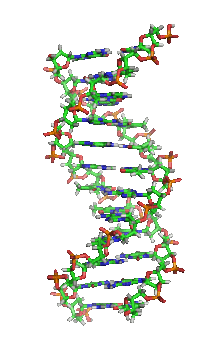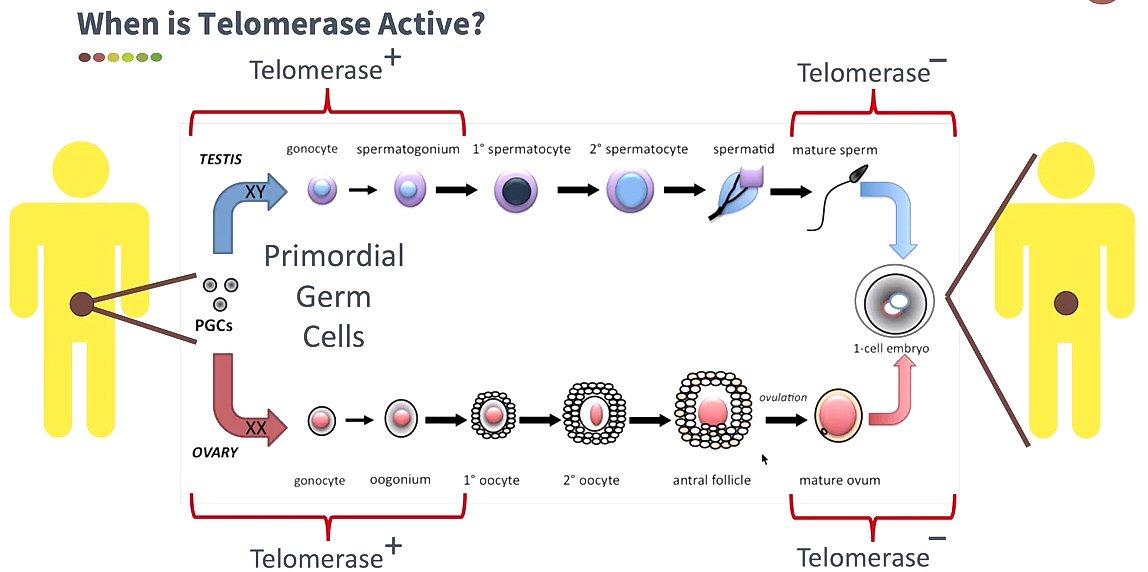The Hayflick Limit
Leonard Hayflick, professor of anatomy at the University of California at San Francisco, advanced the concept 50 years
ago. The Hayflick Limit is a concept that helps to explain the mechanisms behind cellular aging. The concept states that a
normal human cell can only replicate and divide forty to sixty times before it cannot divide anymore, and will break down by programmed
cell death or apoptosis. The Hayflick Limit, he contended, was both an explanation for the phenomenon of ageing and a demolition of the
wishful view (of some) that the human lifespan need have no upper limit. But although he correctly identified the cell nucleus as the
location of the responsible mechanism, it fell to others to discern the structures involved. It was 2009 Nobel Prize winning biologists Elizabeth
Blackburn and Carol Greider who showed how the cell keeps a tally of the number of times it has divided during its progress towards the
Hayflick Limit.
Telomeres had been discovered at UC Berkeley by Elizabeth Blackburn in the 1970s. Then, in 1985 she and then graduate-student
Carol Greider discovered the enzyme telomerase. Greider and her supervisor Blackburn started to investigate if the formation of telomere DNA
could be due to an unknown enzyme. On Christmas Day, 1984, Greider discovered signs of enzymatic activity in a cell extract. Greider and
Blackburn named the enzyme telomerase, purified it, and showed that it consists of RNA as well as protein
The Discovery of Telomeres
In the early phase of her research career, Elizabeth Blackburn mapped DNA sequences. When studying the chromosomes of
Tetrahymena, a unicellular ciliate organism, she identified a DNA sequence that was repeated several times at the ends of the chromosomes.
The function of this sequence, CCCCAA, was unclear. At the same time, Jack Szostak had made the observation that a linear DNA molecule,
a type of minichromosome, is rapidly degraded when introduced into yeast cells.
Blackburn presented her results at a conference in 1980. They caught the interest of Jack Szostak and he and Blackburn
decided to perform an experiment that would cross the boundaries between very distant species, From the DNA of Tetrahymena, Blackburn
isolated the CCCCAA sequence. Szostak coupled it to the minichromosomes and put them back into yeast cells. The results, which were published in
1982, were striking, the telomere DNA sequence protected the minichromosomes from degradation. As telomere DNA from one organism,
Tetrahymena, protected chromosomes in an entirely different one, yeast, this demonstrated the existence of a previously unrecognized
fundamental mechanism. Later on, it became evident that telomere DNA with its characteristic sequence is present in most plants and
animals, from amoeba to man.
Using Tetrahymena, a fresh-water single-celled organism with a large number of telomeres, Greider set out to look for a hypothetical
enzyme that relengthened shortened telomeres. She made extracts from Tetrahymena cells and examined whether artificial telomeres could
be elongated by enzymes present in the extracts. After about nine months of trying variations on these experiments, she identified the
first signs of her enzyme on Christmas Day, 1984. They named it “telomerase” and published their findings in the scientific journal Cell.
Identification of a Specific Telomere Terminal Transferase Activity in Tetrahymena Extracts
Elizabeth H. Blackburn has US and Australian citizenship. She was born in 1948 in Hobart, Tasmania, Australia. After
undergraduate studies at the University of Melbourne, she received her PhD in 1975 from the University of Cambridge, England, and was a
postdoctoral researcher at Yale University, New Haven, USA. She was on the faculty at the University of California, Berkeley, and since
1990 has been professor of biology and physiology at the University of California, San Francisco.
Carol W. Greider is a US citizen and was born in 1961 in San Diego, California, USA. She studied at the
University of California in Santa Barbara and in Berkeley, where she obtained her PhD in 1987 with Blackburn as her supervisor. After
postdoctoral research at Cold Spring Harbor Laboratory, she was appointed professor in the department of molecular biology and genetics
at Johns Hopkins University School of Medicine in Baltimore in 1997.
Jack W. Szostak is a US citizen. He was born in 1952 in London, UK and grew up in Canada.
He studied at McGill University in Montreal and at Cornell University in Ithaca, New York, where he received his PhD in 1977. He has
been at Harvard Medical School since 1979 and is currently professor of genetics at Massachusetts General Hospital in Boston. He is
also affiliated with the Howard Hughes Medical Institute..
New Discoveries - UNDER CONSTRUCTION
So Telomerase is only expressed in embryo cells, adult stem cells and sex cells "Sperm and Egg",
this is why our children are born younger than we are even though they come from our old cells. The Telomerase gene is in every living
Somatic "Body" cell, but it is turned off. |
 |
Researchers at the University of California Berkeley have captured the most detailed images
to date of telomerase, the enzyme that lengthens the ends of chromosomes and plays a critical role in aging. These images provide
long-sought after insight into how telomerase works, and will help guide the design of drugs that target the enzyme, which could have some
interesting implications for cancer and aging. |
 |
Weird DNA
Methuselah is a 4,845-year-old bristlecone pine tree in eastern California, named after the Biblical figure with the
longest lifespan in the Bible of 969 years. Methuselah's exact location is undisclosed to protect it from vandalism. Methuselah was
the world's oldest known living non-clonal organism, until the 2013 discovery of another pine germinated in 3051 BC with an age over
5,000 years. This is the first time that we have identified the detailed structure of the telomerase component from plants, so in terms
of fundamental research, this is a really big breakthrough because now finally we have a way to study telomerase in plants and to
understand how different or similar they are from animals, Could the discovery possibly lead to humans one day living as long as the
fabled "Methuselah" tree, a bristlecone pine species that can live over 5,000 years? Maybe one day.
10 DNA Facts
1. Around 5-8% of your DNA isn't human - it's viral DNA. Scientists believe we carry about 100,000 pieces of DNA
from retroviruses that have accumulated over the course of human evolution.
2. We share 96% of our DNA with primates such as chimpanzees, gorillas and orangutans. - But we are also genetically
related to bananas - with whom we share 50% of our DNA - and slugs - with whom we share 70% of our DNA.
3. Around 99.9% of the DNA in all humans is identical. - It is the tiny 0.1% difference that allows us to be
individuals with different skin, hair and eye colour. Scientists also believe that the remaining 0.1% holds important clues about the
causes of diseases.
4. Humans have approximately 10 trillion cells. - If we unravelled our entire DNA, it would stretch six billion
miles - which would be the same as travelling from the Earth to the sun 65 times.
5. Although rare, it is possible for a person to have two completely different DNA profiles. - a phenomenon known as
chimera. It can happen during a normal pregnancy - where the mother retains some of her baby's DNA - or when a foetus absorbs its twin. A
person can also be a chimera if they undergo a bone marrow transplant where the donor's bone marrow continues making blood cells that have
the donor's DNA.
6. Almost all the cells in our body have DNA - the exception being red blood cells. However, all red blood cells
start with DNA - they simply destroy their nucleus once it is no longer needed as part of the maturation process.
7. Human beings have 20,000 to 25,000 genes but they account for only about 3% of our DNA. - Scientists are not sure
about the function of the remaining 97%, although they think it may have something to do with controlling the genes.
8. The human genome contains three billion base pairs of DNA. - It is estimated that if you type eight hours a day
at 60 words per minute, it would take approximately 50 years to type the human genome.
9. Unlike the octopus, we can't naturally edit our own genes. - But scientists have developed a complex
protein-based tool called CRISPR-Cas9 which has been used to successfully alter DNA in defective embryos to prevent inherited diseases.
10. We all know about the double helix structure, but scientists have recently discovered another form of DNA in
living human cells. - It's called i-motif and has been described as "a four-stranded knot of DNA".
Free Hit Counter supplied from www.hitwebcounter.com - CLICK HERE
You are guest number - Since 06\04\2022

Please visit again
IN-AP Systems - Established 1997
A computer is like the mind, it has IN-finite AP-plications. . .
HOME PAGE




